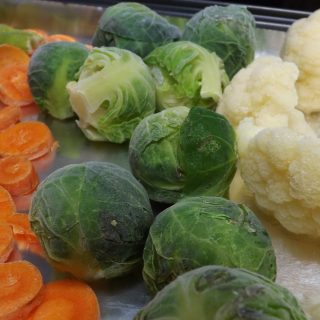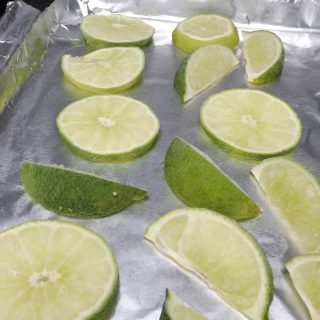Salsa is one of our favorite things to make with our garden harvest. Nothing can beat the spicy bite that comes along with fresh tomatoes, crisp peppers, and a whole host of tasty spices. We like to make large batches so it can last a long time. We usually will can it after we make it but we recently got to wondering can you freeze salsa?
You can freeze just about any type of salsa. Salsa verde freezes the best, from what we can tell. The best results come from pre-cooking the excess moisture out of the salsa before bagging it in freezer bags for freezing. Salsa is easily defrosted in the fridge overnight, in the microwave, or on a stovetop.
Once it thaws it is pretty watery and is best used in recipes. Freezing will extend the life of your salsa by about a month or two but should be eaten well before then for the best flavor.
It's not all doom and gloom though. There are plenty of ways to keep your salsa tasting great even after your freeze it. Let's find out how!
[ez-toc]
Can you freeze salsa?
Salsa is one of those foods that actually freezes very easily. This is because it is loaded with water and has a ton of moisture in it. While this makes it taste great, it can make the results of freezing not quite as satisfying.
Much like other liquid or soft foods, like when freezing milk or freezing half and half, freezing apple sauce, freezing chili and Freezing sauerkraut, salsa freezes best in small portions at a time. We prefer to use quart size bags or even salsa pods frozen in an ice tray.
Freezing Stats
| Blanched | no |
| Prep Style | make it yourself or freeze store bought |
| Time To Freeze | within a few hours |
| Time to Thaw | overnight in the fridge, a couple of minutes in the microwave or stovetop |
| Uses | recipe ingredient marinades dip (after thickening) |
| Freezer Life | 1 to 2 months |
Why should you freeze it?
Probably the main reason to freeze salsa instead of canning it is the time it takes. Like with any freezing food, it is almost always the fastest way to preserve food.
Canning is a big process and can take a while to do it properly. It also take specific canning equipment, Mason Jars, lids, rings, and some other items.
To freeze salsa all you need are some freezer bags, a sharpie, and a freezer. It also takes less than half the time it takes to can.
Frozen Vs Canning
| Freezer Life | Shelf Life/Fridge Life (canned) |
| 1 to 2 months | 12 to 18 months |
Supplies
- salsa
- sauce pan
- cookie sheet (for freezer shelf)
- ice cube trays (for salsa pods)
- Measuring cups
- Freezer bags
- Sharpie or marker
- Freezer
Need to get all your food preserved easily? Check out the Ultimate Guide To Freezing Food so that you can fill your freezer without in minimal time.
How To Freeze Salsa
Let's go over the 4 easy steps it takes to freeze salsa.
Step One
As we mentioned above, salsa has a lot of moisture and, once frozen and thawed, will become very runny. One way to combat that is to cook off some of the excess moisture before you start freezing.
Put your salsa in a sauce pan and heat it on low or low-medium until it starts to simmer. Keep the heat as low as you can while still maintaining a slow simmer. What is happening is the water in the salsa is starting to evaporate. You want to do this as long as you can without the tomatoes and other ingredients breaking down.
Once the other ingredients start breaking down the salsa will start to thin out again. Keep an eye on it and you will pick up on how long you can tow that line. While you are waiting for it to start simmering you can gather the rest of your supplies together.
Pro tip: Add a couple cans of tomato paste to the pot with the salsa to give it some extra thickness.
Step Two
After your salsa has finished cooking down and you have taken it off the stove, set it to the side and let it cool for a while. You don't want to put hot salsa in the freezer. It will increase the temperature inside the freezer which can cause some condensation to form. This condensation (aka water) can then get into your salsa, watering it down, and defeating the entire purpose of cooking it down to begin with.
While it's cooling, if you haven't already, figure out what portion sizes you are going to want to freeze. You can freeze small little snack pods using an ice tray, a whole batch in a plastic jar, or a cup at a time in plastic bags.
Smaller portions tend to work best because they will freeze more quickly. The faster they freeze the less likely you are to experience freezer burn. Also, smaller portions are more likely to be eaten with no need to refreeze.
Step Three
Now that you have decided your portion size, get your freezing containers together. Your salsa is probably still cooling so you have a little more time to go.
If you are not using a plastic jar, then freezer bags are the best route even with salsa pods. Write the contents, freeze date, and "best by" date on the outside of the bag or jar. It's important to include all of this information so you don't end up eating something that has passed it's use by date. You may remember but someone else may not and just get excited they found some salsa.
Step Four
At this point your salsa may be cool enough to start portioning and bagging. If not, walk away for a while and come back later.
If you are just freezing in a jar, fill the jar up and stick it in the freezer. That's it and you're done.
Freezer bags take a little bit longer. We like to freeze about a cup or two at a time. So we fill the bags up and squeeze as much air as we can out of them. Excess air will cause sublimation to occur. Sublimation is the process that eventually leads to freezer burn. So get that air out!
Place a cookie sheet on a shelf in the freezer and start laying your flattened bags of salsa out on them. The cookie sheet is to keep the salsa from forming to the shelf grate and then freezing; becoming stuck in the process. Freezing them flat will make them much easier to move around if you need to rearrange your freezer later.
If you want to make salsa pods, just fill up a couple of ice cube trays with salsa. Put the trays in the freezer for a couple of hours. Come back later and pop the salsa pods out and put them into a pre-labeled freezer bag.
Pro tip: The most effective way we have found to remove all of the air from a bag is to zip it almost completely closed with a small opening on one end. Then submerge the rest of the bag in water. The water pressure surrounding the bag will push all of the air up and out through the small opening.
Just be careful to not get water in the baggie.
How do you defrost salsa?
You can thaw salsa by leaving it in the fridge overnight or running it under cool water. Alternatively, it can also go straight into a recipe, be warmed on the stove, or nuked in the microwave.
Unfortunately, freezing salsa will impact the firmness and texture of the vegetable ingredients. This can lead to an almost soggy consistency and texture.
However, it will still taste good, just not quite as bright and lively as a fresh jar would taste.
How can I use frozen salsa?
Freezing will affect the texture and consistency of your salsa. It can become watery due to the excess moisture that comes with freezing. You will have the most success if you use thawed salsa as an ingredient in larger recipes.
Frequently Asked Questions
Here are some of the more common questions about freezing salsa.
Q1. How long will frozen salsa stay good?
Frozen salsa will keep for up to a year when frozen. However, it will start to degrade in flavor and quality pretty quickly. You can usually get a month. You'd be lucky to get two months with its flavor still at a desirable level.
Q2. Can I freeze store bought salsa?
Store bought salsa is just as easy to freeze. If it came in a plastic jar, all you have to do is stick the container in your freezer without opening it. If the jar is made of glass you will need to transfer the salsa into a plastic container. When the salsa freezes it will expand. This expansion will cause the glass jar to shatter making a big mess and can be dangerous.
Final word
So, we've learned that salsa is pretty easy to freeze. It takes a little extra effort to keep it from being too watery, but simple, none the less. It is pretty clear though that, if it's possible, canning salsa is the best route for long term preservation. But if you are just trying to keep a couple jars worth good for a month or so, freezing is a quick and easy way to do that!
If you need more help getting your foods frozen, check out the Ultimate Freezing Food Guide for a complete quick start reference so that you can have a well-stocked freezer.


